A Complete Look at The Pinebook Pro
I happened to be weedwacking some weeds out of my yard one sunny afternoon when the mailwoman dropped off a medium-sized yellow package on the front step. I carefully observed the way she placed it — and through my shades I could tell she dropped it gingerly.
Thanks, mailwoman.
I eagerly stop what I’m doing and open up the DHL bag to reveal an orange envelope. Thin cardboard box after another cardboard box later, and I get a letter that reads:

Next, beneath a thin piece of foam, lies something black and rectangular.
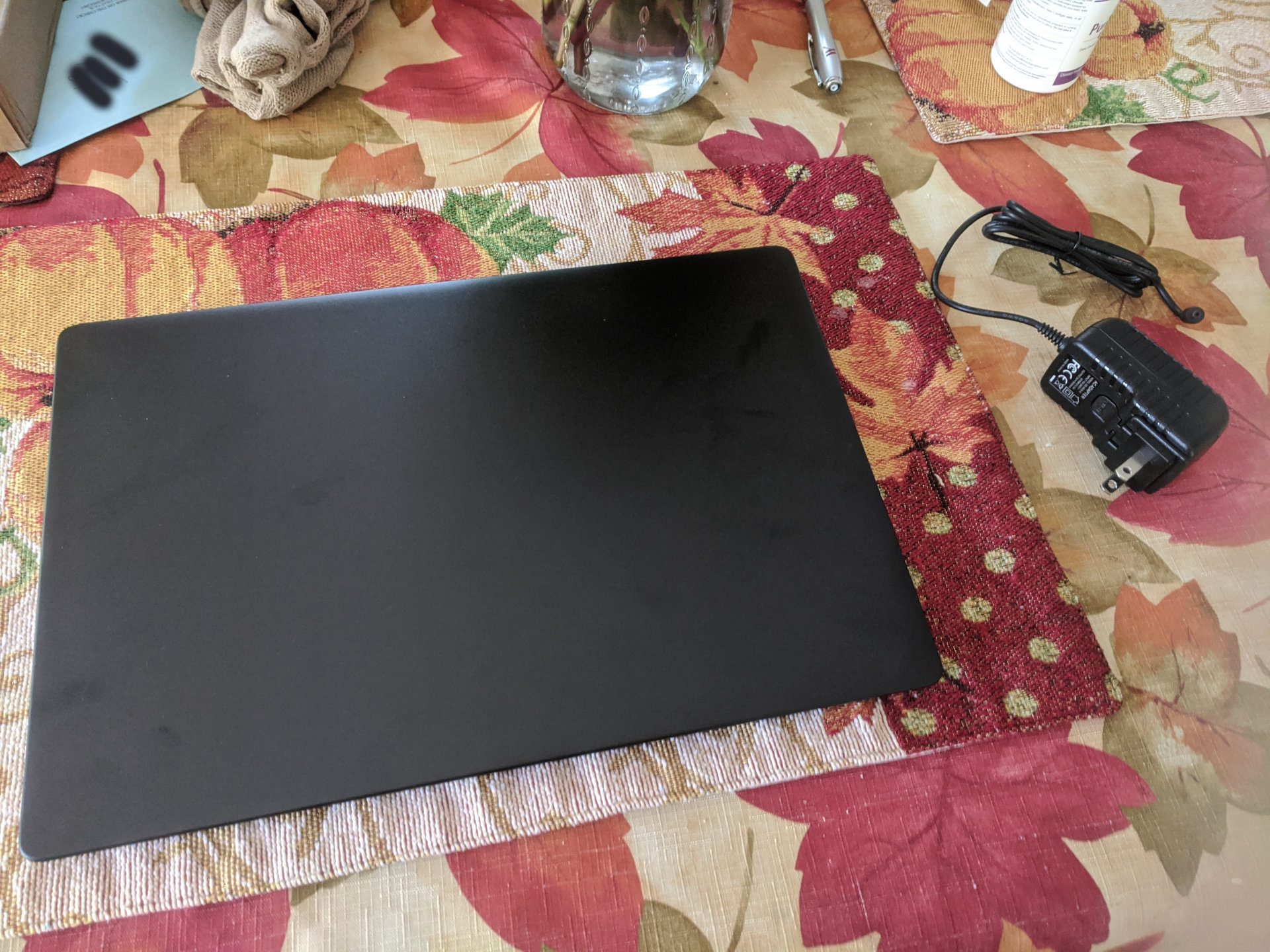
You already know what that is.
The first thing that amazed me was how incredibly thin the product is. According to the Pinebook Pro’s (here on referred to as PBP) specifications, it sits at just twelve millimeters high and weighs less than three pounds (or 1.26Kg). That’s lighter and thinner than a Macbook Air.
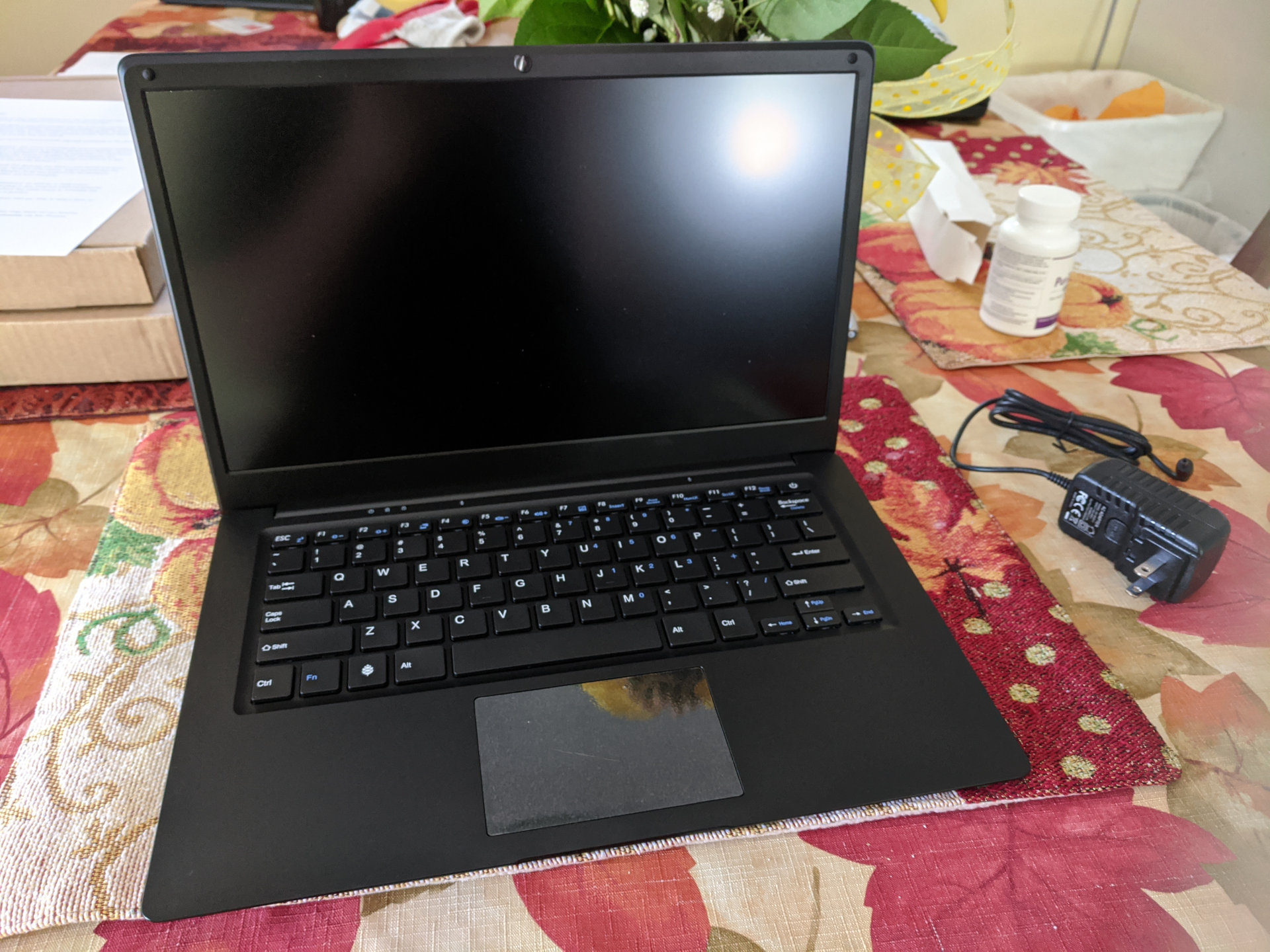
Let that sink in for a minute.
Next, upon lifting the laptop’s magnesium alloy lid, revealed a fourteen-inch IPS LCD screen, along with a full-sized keyboard and trackpad. What would normally be the Windows key is actually the Pine64 logo, and instead of having a separate button for the power, the power switch is the upper-right key on the keyboard.

Since the past few months, the team at Pine64 decided to ship the PBP with Manjoro KDE pre-installed, due to how well they’ve been working together with the Manjaro community. So, upon starting the device by holding the power key for about a split-second, the first thing you’ll see is the Manjaro logo, underneath which lies a loading circle that oddly looks and behaves very similar to the Windows 8/10 loading circle. Next, you’ll be prompted through a text-based interface as to what keyboard layout you desire, as well as language, setting up users and passwords, and the like. There are no options to set up encryption during setup, but I imagine it would be possible to encrypt the PBP’s contents by following the Arch Wiki guide.
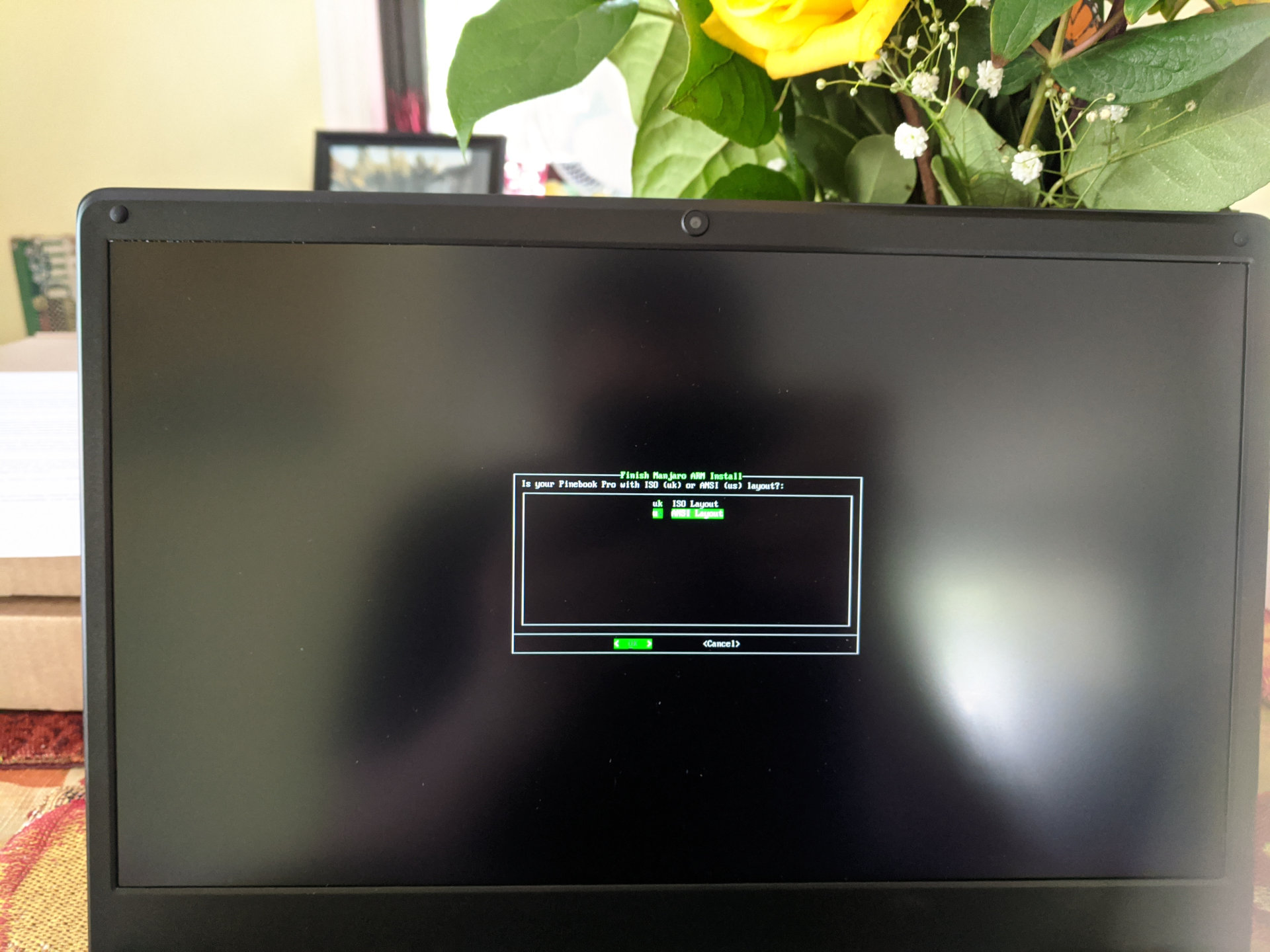
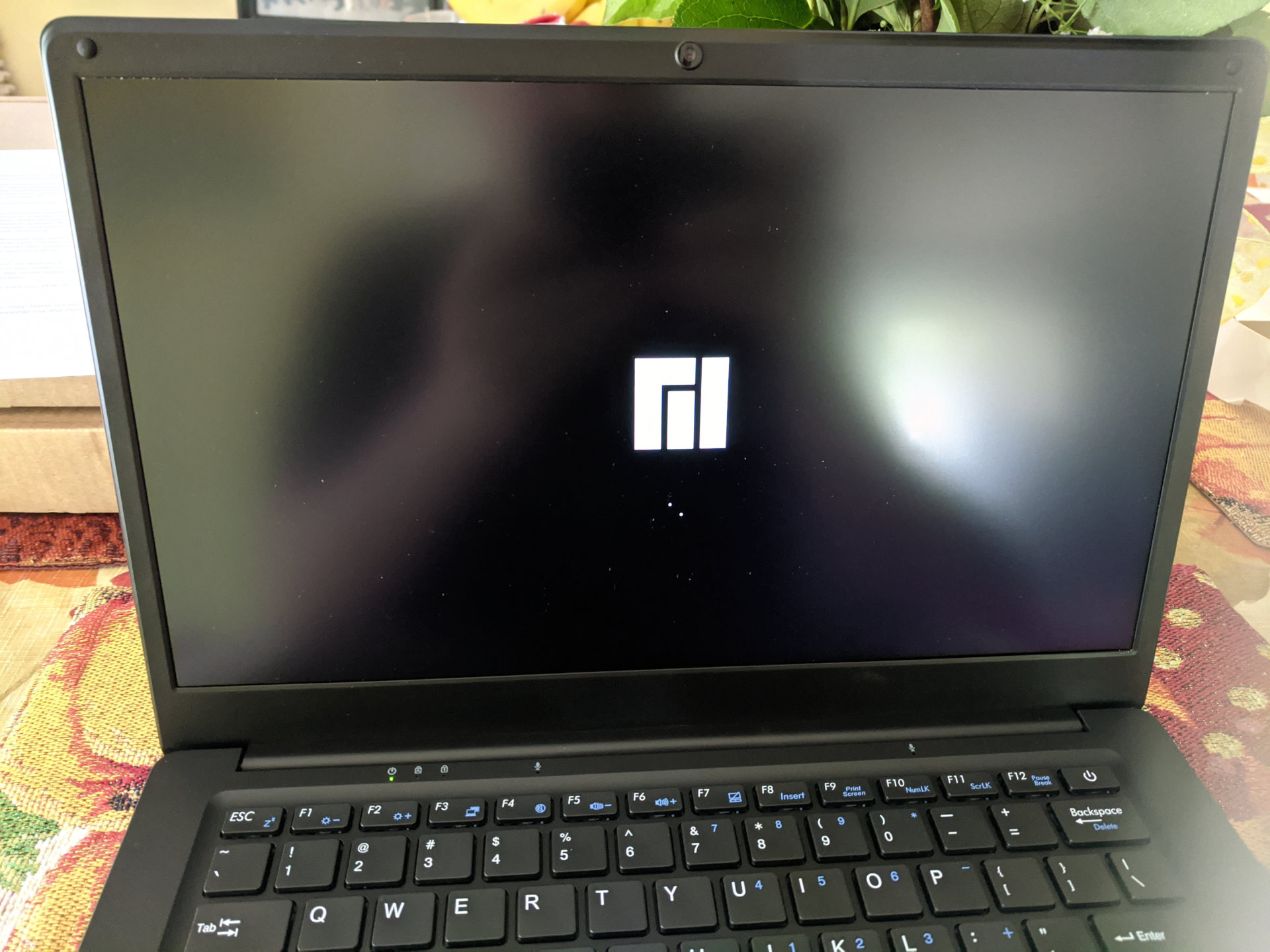
Eventually you’ll get to the desktop:

Although, bear in mind I took this screenshot after I had installed some applications. The taskbar at first will only have three applications: Firefox, Dolphin (file manager), and Konsole (the terminal).
According to the Pine64 Wiki, the PBP “is built to be a compelling alternative to mid-ranged Chromebooks that people convert into Linux laptops.” But seeing as how affordable the unit is, and not having a charger for my other laptop, I decided to try out the PBP.
Hardware
The PBP measures 329 millimeters across the board, 220 mm in length, and 12 mm high. The internal hardware is encased in a black magnesium alloy finish. All around the laptop, including the top, underside, and the palmrest, are very minimalistic in design.
The bottom of the unit is like the topside of the lid in terms of its simplicity, albeit some additions: a rubber pad for each corner, small oval-shaped speakers on each side for stereo output, Philips screws for disassembling the unit, and a sticker on the bottom-right with the certification label. The use of Philips screws allows for easy disassembly and reassembling.
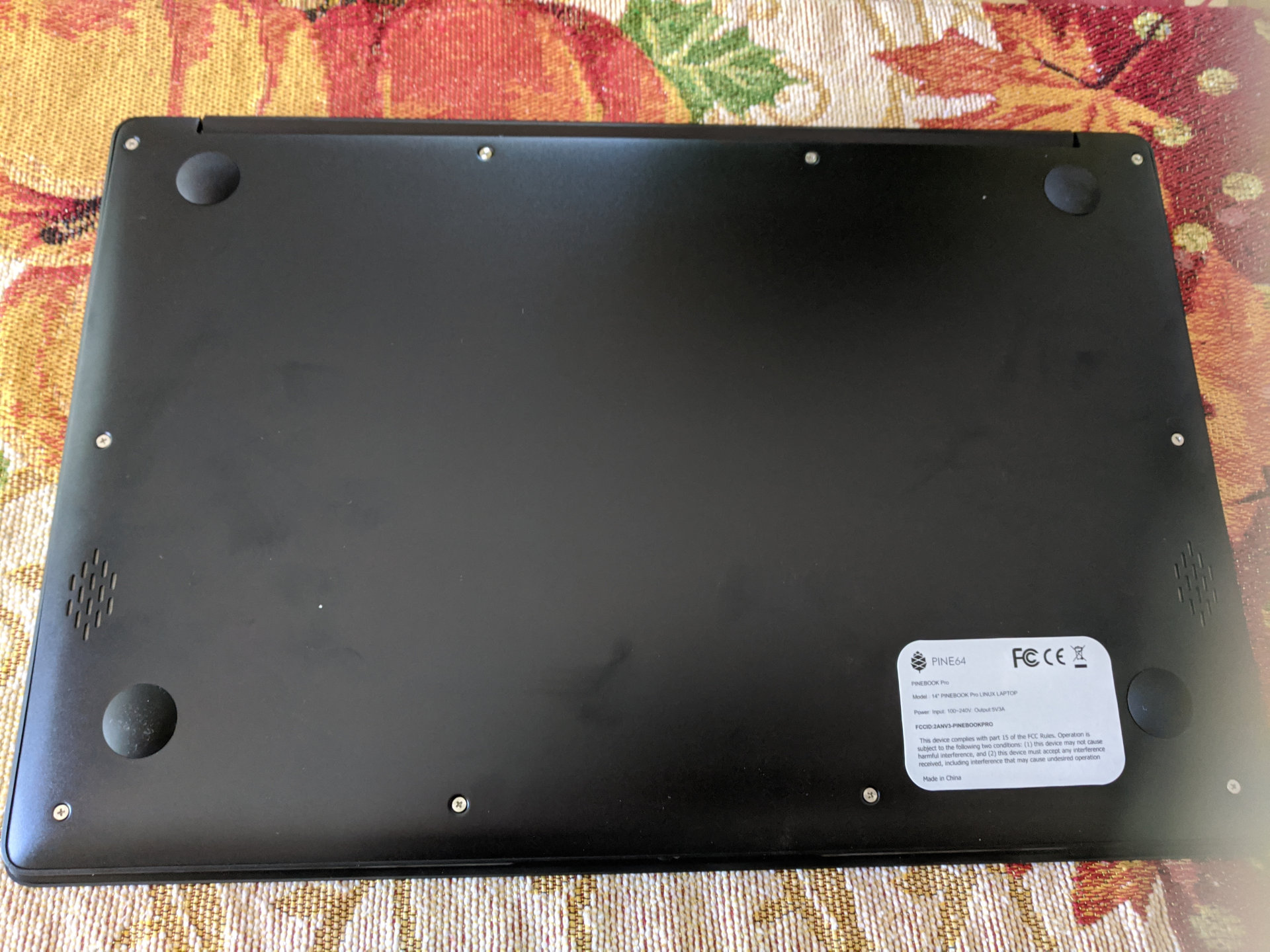
Filling in part of the left side of the unit is a small barrel jack for charging, a USB 3.0 port, and a USB type C port. Included with the PBP is a 5V AC adapter that comes with two different plugs; you can swap the contacts of the plug with the appropriate one that will fit in your electrical outlet. Charging can also be accomplished via the USB-C port. You can also use this port to connect to an external monitor, provided you have the adapter.
On the right side is a USB 2.0 port, a headphone jack, and a MicroSD card slot. With a MicroSD you can flash one of the compatible operating systems, including RecalBox, and run it by inserting the card into the unit and powering the device on. The MicroSD card takes boot priority over the eMMC. Of course, you can also flash an OS directly to the eMMC.
Display
The underside of the lid is a LCD screen that measures fourteen inches diagonally and outputs 1080p. The screen size may make it a bit difficult for some because text may be a bit small for them. The Pine64 Wiki lists a few things that they can do, such as, well, increase the text font size. However, the Wiki warns not to change the display resolution, as this may produce a black screen. The font size isn’t much of a problem for me though.
The display has a refresh rate of 60 Hz and uses the eDP MiPi protocol. Looking at the screen from an angled viewpoint doesn’t look any different than a straight viewpoint. Colors are what they should be: no color display shift here as opposed to certain other displays. It’s pretty good quality for what you’re getting.
Webcam
Above the LCD panel lies a webcam that, according to the Pine64 Wiki, is capable of taking pictures up to 1600 x 1200 resolution at 1.92 megapixels. I definitely don’t recommend recording with the webcam though; after installing Cheese the lag on the webcam was insane.
Here I took a picture of my NES case for my Raspberry Pi 3:

As you can see, the webcam quality isn’t great by any means, but it’s not terrible either.
Keyboard/Trackpad Area
When ordering the PBP, you can choose between the ISO keyboard layout (for those in the UK) or the ANSI layout (US). The keyboard is full-sized, and like I mentioned earlier, it uses the Pine64 logo instead of the traditional Windows logo. So far I’m not having any issues using this keyboard as I type this review. Powering on the unit is as simple as holding the power key for half-a-second or so. The Power LED, located just a little above the F2 key, will briefly flash red before turning a solid green color.
A few other LEDs are lined up next to the Power LED that turn green when Caps Lock or Num Lock is turned on. There’s also two Microphone LEDs — I’m honestly not sure why there’s two, but I’m curious as to finding that out.
Like most laptops, extended features can be toggled by using a combination of the Function key and any of the keys that have small blue print on them. So, for instance, holding Fn + F1 or F2 changes the brightness of the LCD, Fn + F3 changes the display output mode if the PBP is connected to an external monitor, and Fn + F4 mutes the audio output.
The trackpad stretches just a little wider than the spacebar and is about two inches long. It’s composed of a matte finish and is capable of doing what most other trackpads can do: right-clicking and scrolling with two fingers, and a left-click and right-click in their respective areas toward the bottom. The trackpad can be disabled on-the-fly with Fn + F7.
Killswitches
A unique feature to the PBP in contrast to most other laptops are killswitches. With a combination of F10-F12 and the logo key, we can kill the following services:
- Microphone
- Wi-Fi
- Webcam
Since the firmware the keyboard uses is separate from the operating system itself, these killswitches are hardware-based. Per the Pine64 Wiki:
The keyboard operates on firmware independant of the operating system. It detects if one of the F10, F11 or F12 keys is pressed in combination with the Pine key for 3 seconds. Doing so disables power to the appropriate peripheral, thereby disabling it. This has the same effect as cutting off the power to each peripheral with a physical switch. This implementation is very secure, since the firmware that determines whether a peripheral gets power is not part of the Pinebook Pro’s operating system. So the power state value for each peripheral cannot be overridden or accessed from the operating system. The power state setting for each peripheral is stored across reboots inside the keyboard’s firmware flash memory.
You’ll know whether the service has been killed or not by the number of times the Caps Lock or Num Lock LEDs blink.
Bluetooth can also be killed by issuing a few commands from the terminal. Re-enabling Wi-Fi after killing it will require a restart (alternatively, a few commands can be run without needing to restart).
Audio Input/Output
After playing a few videos on YouTube with the sound cranked all the way up, the unit is not terribly loud, but still good enough for watching movies. Sometimes you’ll hear a bit of crackling depending on the volume the video itself is set to if the PBP’s volume is set to 100%. Decreasing the volume a bit lower will get rid of this. I definitely wouldn’t recommend video conferencing though if you’re using your webcam.
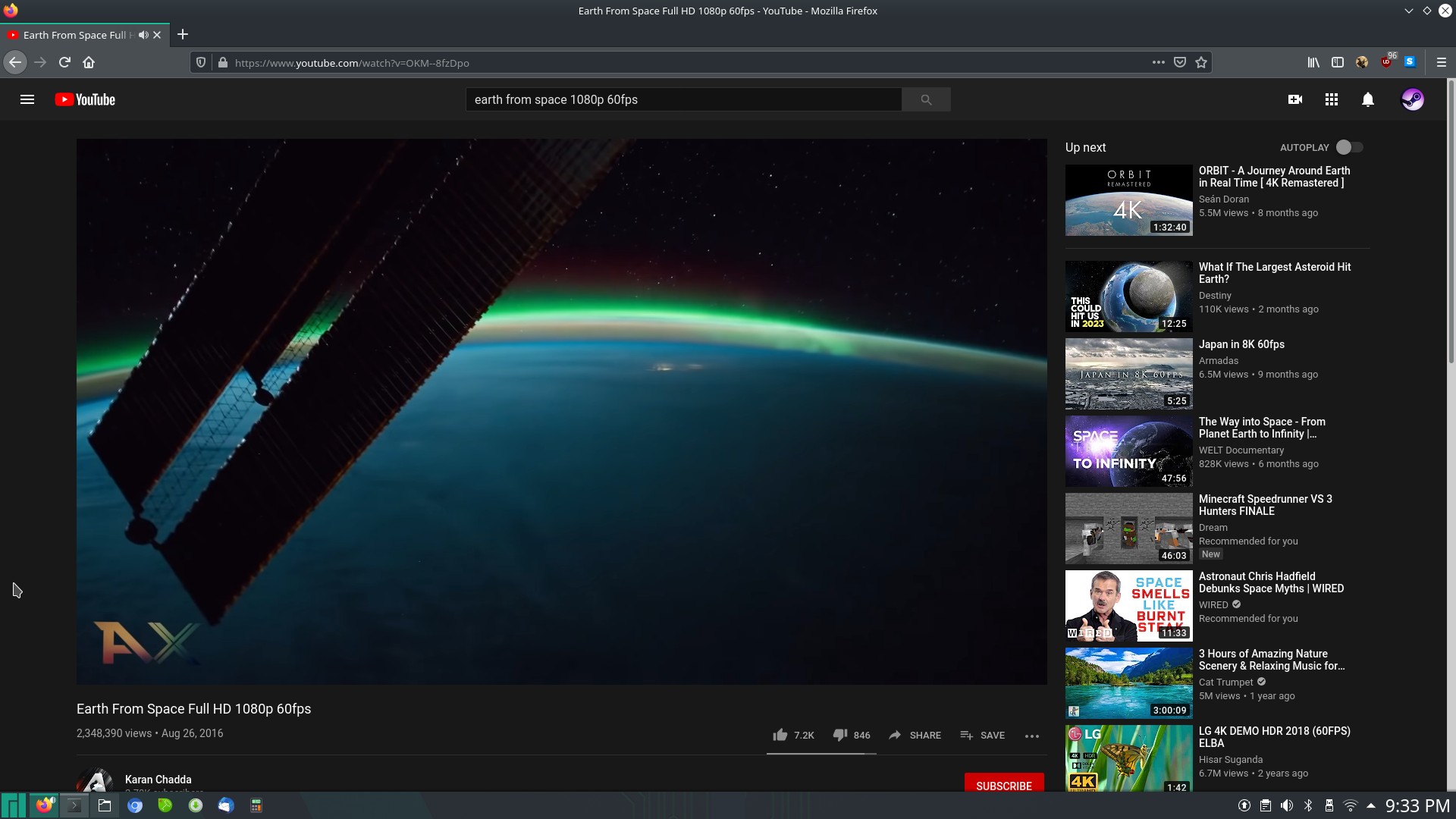
I did a brief video recording with SimpleScreenRecorder to record my voice and the desktop itself. The microphone works, but I had to increase the input volume by 150% so you can hear me, the side effect being that other background noises are also picked up. Video playback itself was captured at 30 FPS, but you can tell it’s frameskipping a little to compensate.
External Monitor Connectivity
So here’s the funny thing about external monitor support during my testing. At first, it worked. I pressed Fn + F3 to change the monitor output, and I can confirm I could get video output on my monitor. Sound was still playing through the PBP itself. There wasn’t any other sound output device that I could change to in the Sound settings. As I try it now, though, it simply won’t work. I have the USB C to HDMI adapter plugged into my PBP, then connected an HDMI cable from there to my monitor, and the monitor will refuse to display the image, even after rebooting the laptop.
The Internals
Onto the actual bread of the unit. The primary component that’s firing all of this together is a six-core system-on-a-chip (SoC) dubbed the Rockchip RK3399, clocked at 1.4 GHz. The GPU it’s using is called the Mali T860 MP4 and uses the open-source Panfrost driver. 4 GB of LPDDR4 RAM is supplied, along with 64 GB of eMMC storage. Apparently the eMMC can be upgraded to 128 GB. Additional capacity can be produced from a flash drive, a MicroSD card, or an M.2 NVMe slot (you will need an adapter for this).
The PBP has an SPI flash device, which stores the bootloader. The battery’s capacity is 10,000 mAH. The Wi-Fi module is capable of connecting to both single- and dual-band networks, up to the 802.11ac standard, and Bluetooth 5.0 is supported. Serial output can be done using the appropriate headphone jack and enabling the UART switch. This function is useful for developing or debugging purposes.
Overall I’m very pleased with the aesthetic of the PBP; its minimalistic design leaves less of an eyesore and less of an intimidation to users who may not have experience with more complicated layouts. Plus, we can add our own stickers or design later on; we could even customize the skin. For a $200 product, the quality of the materials is a steal. Shipping costs are a different problem, but I know that’s something Pine64 can’t do anything about.
In case anyone wants more info about the hardware of the PBP, refer to the Wiki.
Software
The PBP ships with Manjaro as the default distribution, and KDE as the desktop environment. For those who aren’t aware, Manjaro is based on Arch Linux and uses a rolling release software model. Software is more up-to-date and updated more frequently than Debian-based distros. Manjaro uses pacman as the package manager. 6 GB of swap space gets automatically assigned to the eMMC.
In case Manjaro isn’t to your liking, there’s a host of other options to choose from, including Ubuntu, Fedora, openSUSE, Kali Linux, and Android. As I’m reviewing this unit I wanted to keep Manjoro as my default distro to have as streamlined of an experience possible.
Using a stopwatch to record boot time, it takes roughly 30 seconds to reach the login screen, then another 15 seconds for the desktop to fully load.
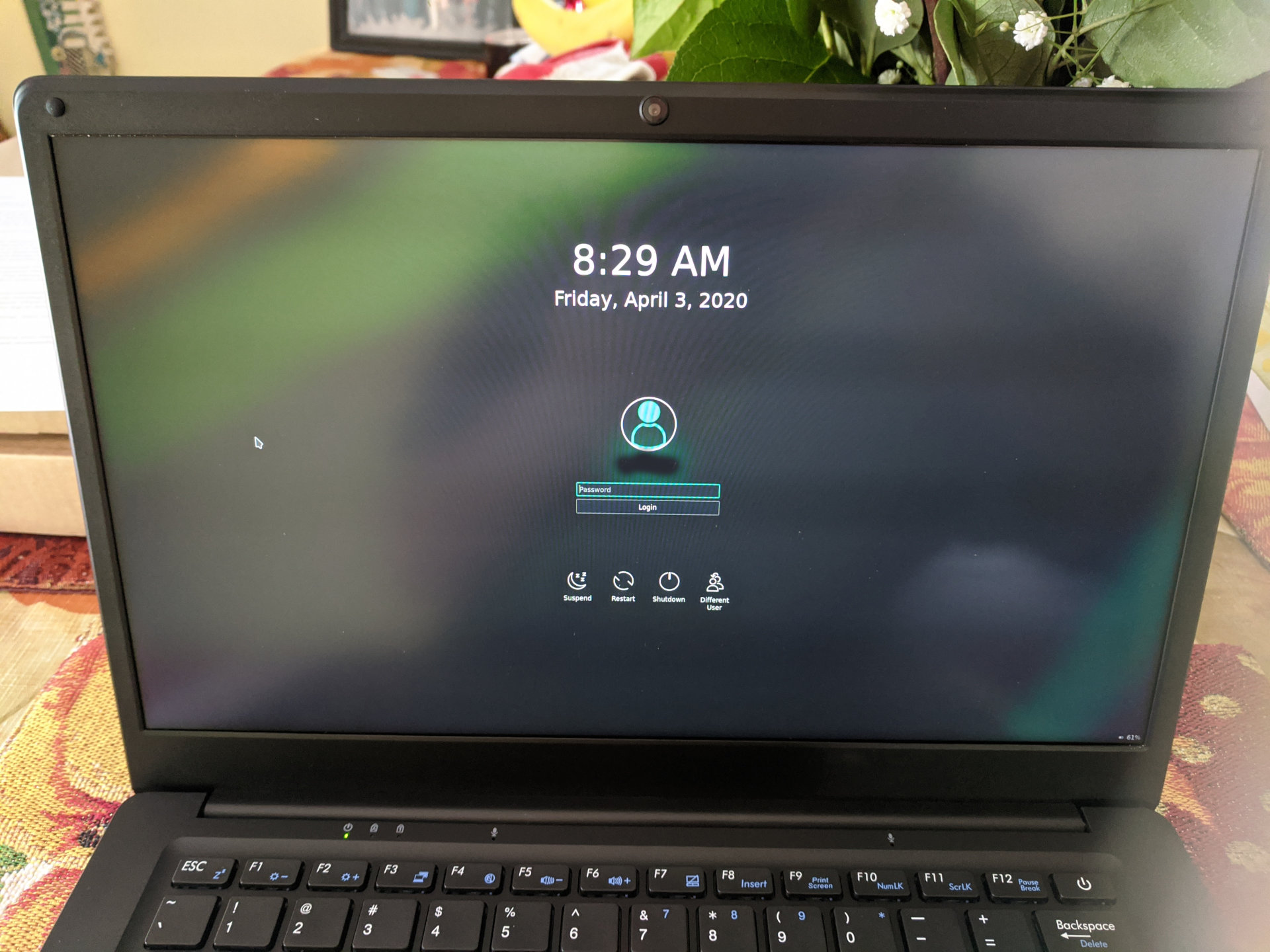
Here we’ve got a few customized wallpapers for the PBP:
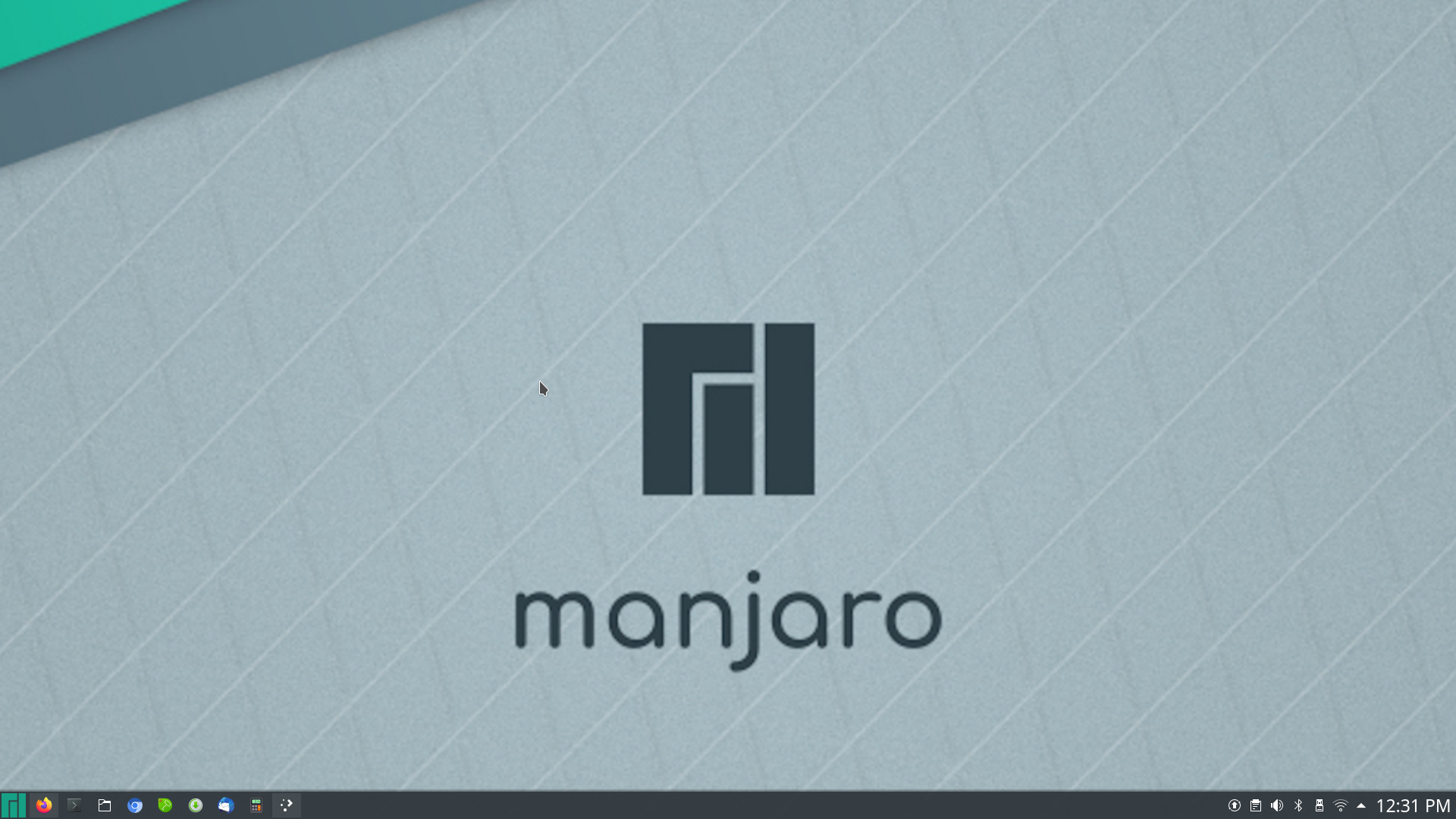
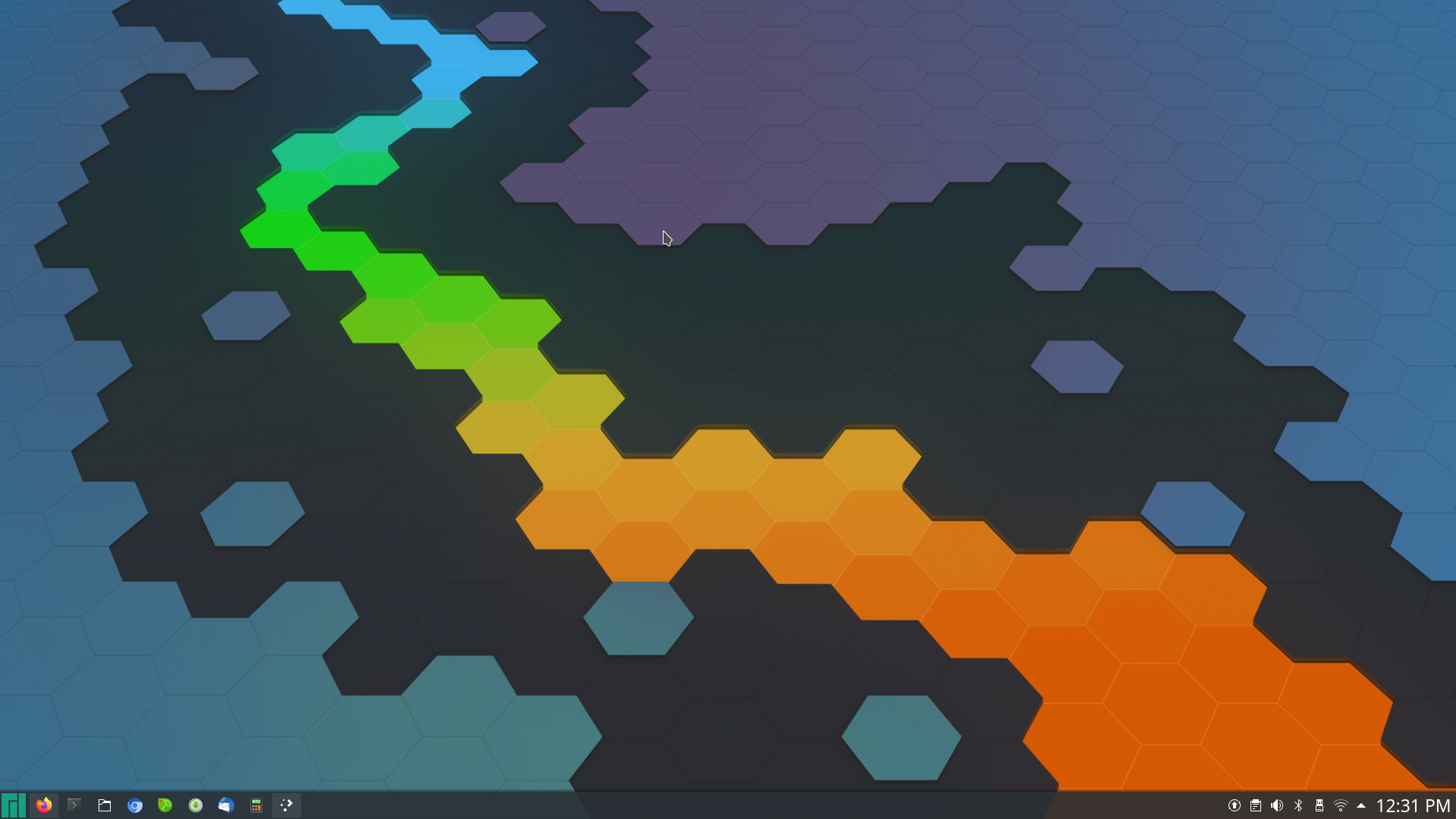
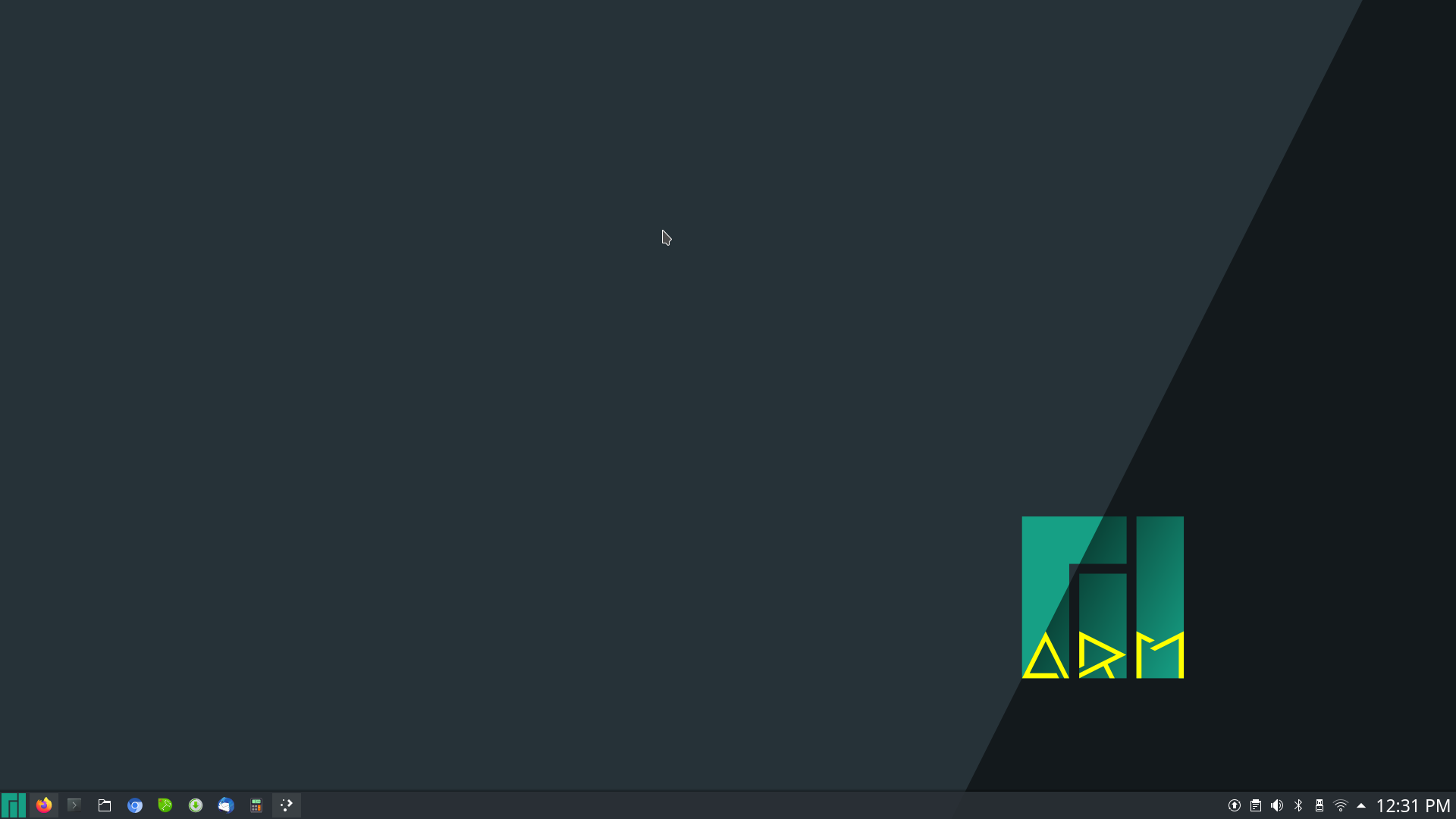
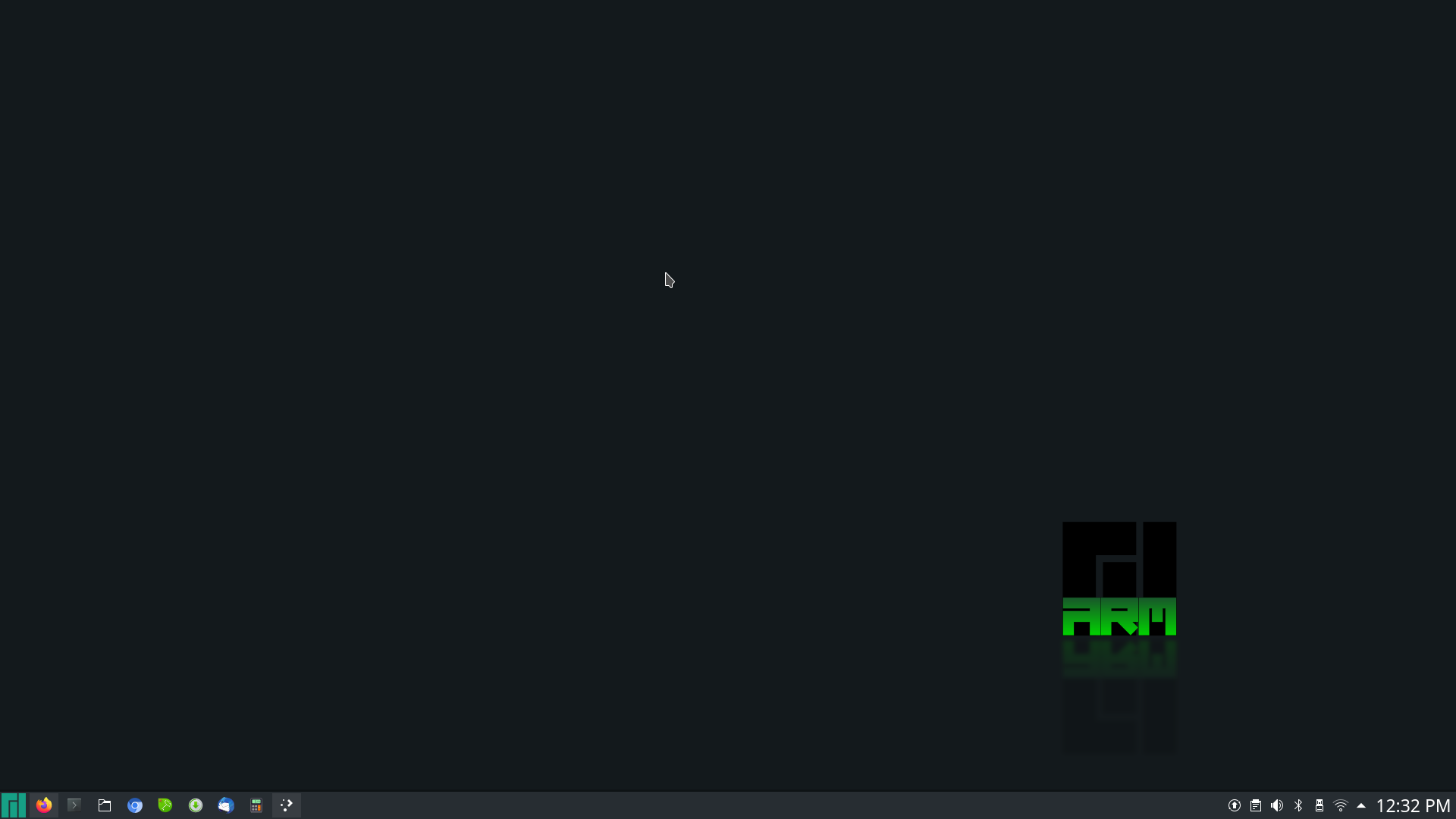
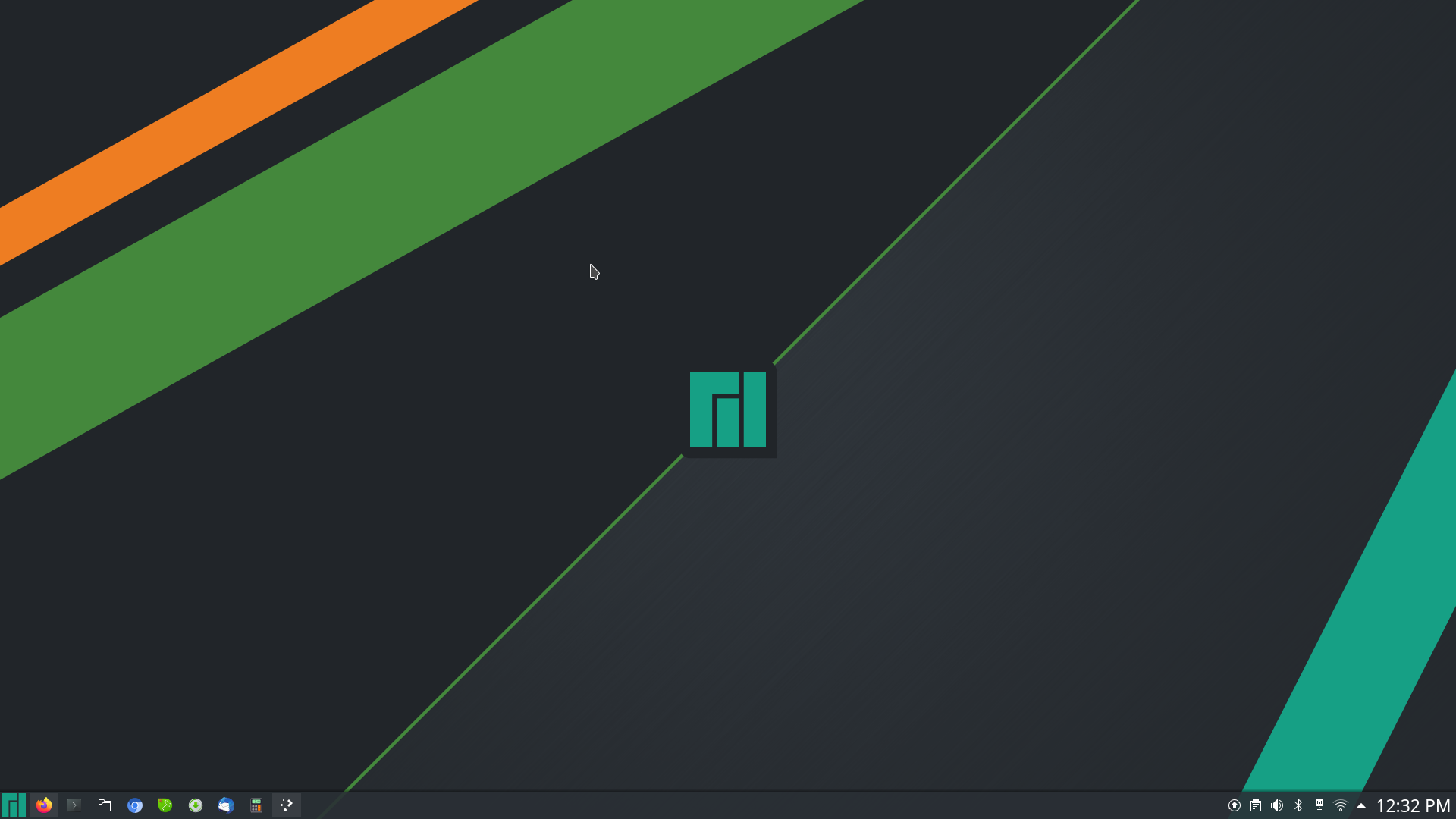
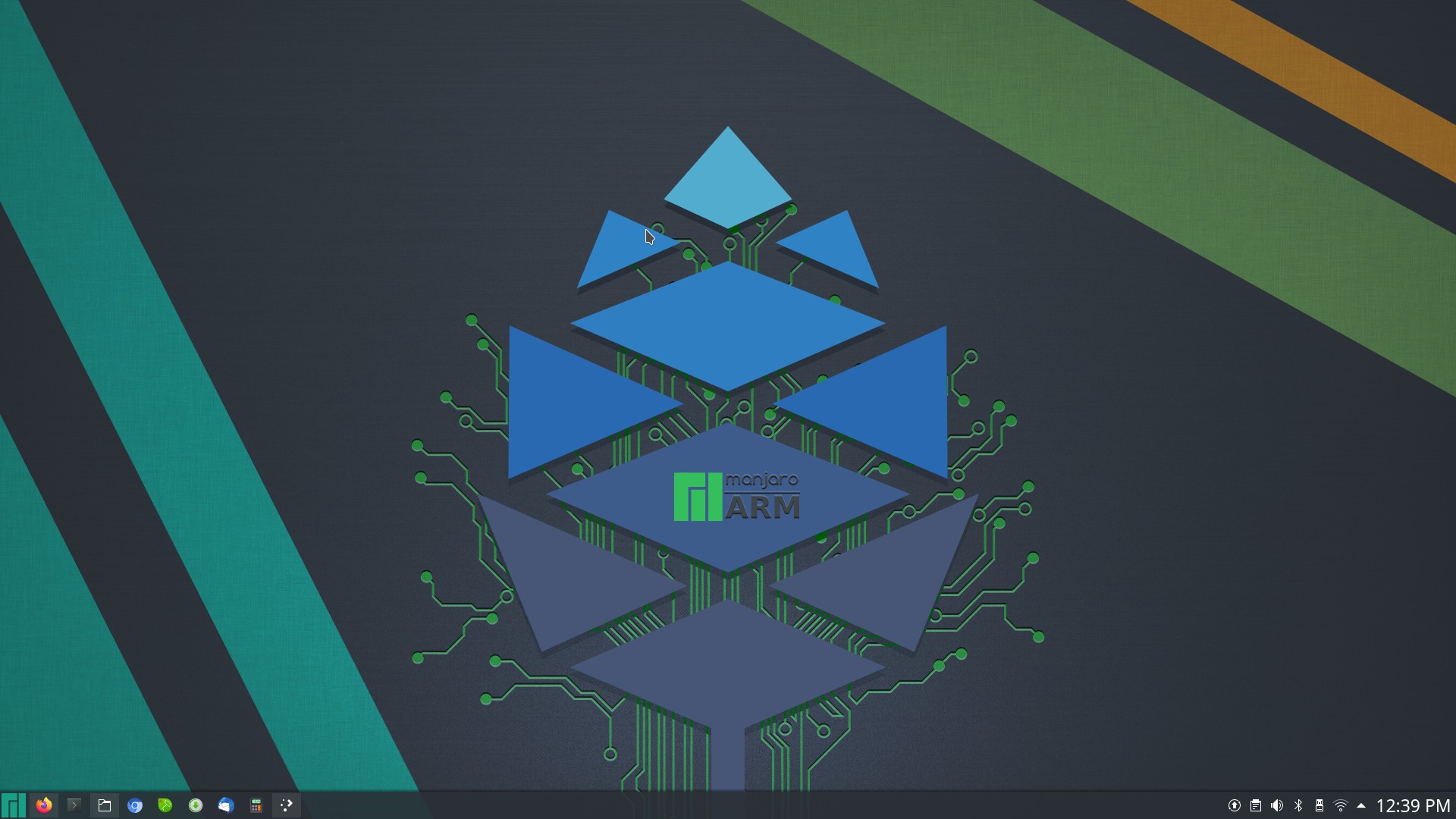
It comes with the following packages out of the box:
- Cmake/Electron/Qt Utilities
- LibreOffice
- Gwenview
- Okular
- Firefox
- Avahi SSH/VNC server
- mpv Media Player
- Dolphin file manager
- Kate text editor
- Spectacle screenshot utility
- Ark archiving tool
- K[insert name of KDE application] that are supplied by default with KDE, such as Konsole and KSysGuard
One major difference between the PBP and most laptops, is that the PBP is using the ARM architecture. So a lot of the software that you’re used to running — Steam, Spotify, Discord, etc. — won’t run here, as those applications require the x86 architecture. The applications you use have to be compiled specifically for the ARM platform. The good news here though, is a lot of the other software you use, you can use like you were operating them on a desktop, such as Firefox, Chromium, Thunderbird, LibreOffice, and even GIMP. A list of programs that can be installed specifically for the PBP can be found in the Add/Remove Software application.
With QEMU, we can actually install x86 operating systems. A user on YouTube was able to get Windows XP running, but I’ve no idea how well x86 applications on such an OS would work. And don’t even bother trying to use Box86, as I was unable to compile it.
Thanks to the multi-tasking features of modern web browsers, apps like Discord and Riot can be used directly within them. I was, however, encountering issues with Spotify’s web player. Since it uses DRM, DRM playback needs to be enabled. But you can’t do that here, either because it’s this version of Firefox or perhaps just a general ARM issue. You can install Chromium with Widevine enabled to play DRM content, but as I tried to launch the application nothing happened.
How Much Can We Push It?
To push the PBP to its limit, I had four tabs opened in Firefox, one of which was playing a video on YouTube, a file manager opened, GIMP opened, and a terminal downloading some soundtracks. You’ll notice from the output below, RAM consumption wasn’t much of an issue, as it was barely going over 2 GB, but the cores were almost maxed out.
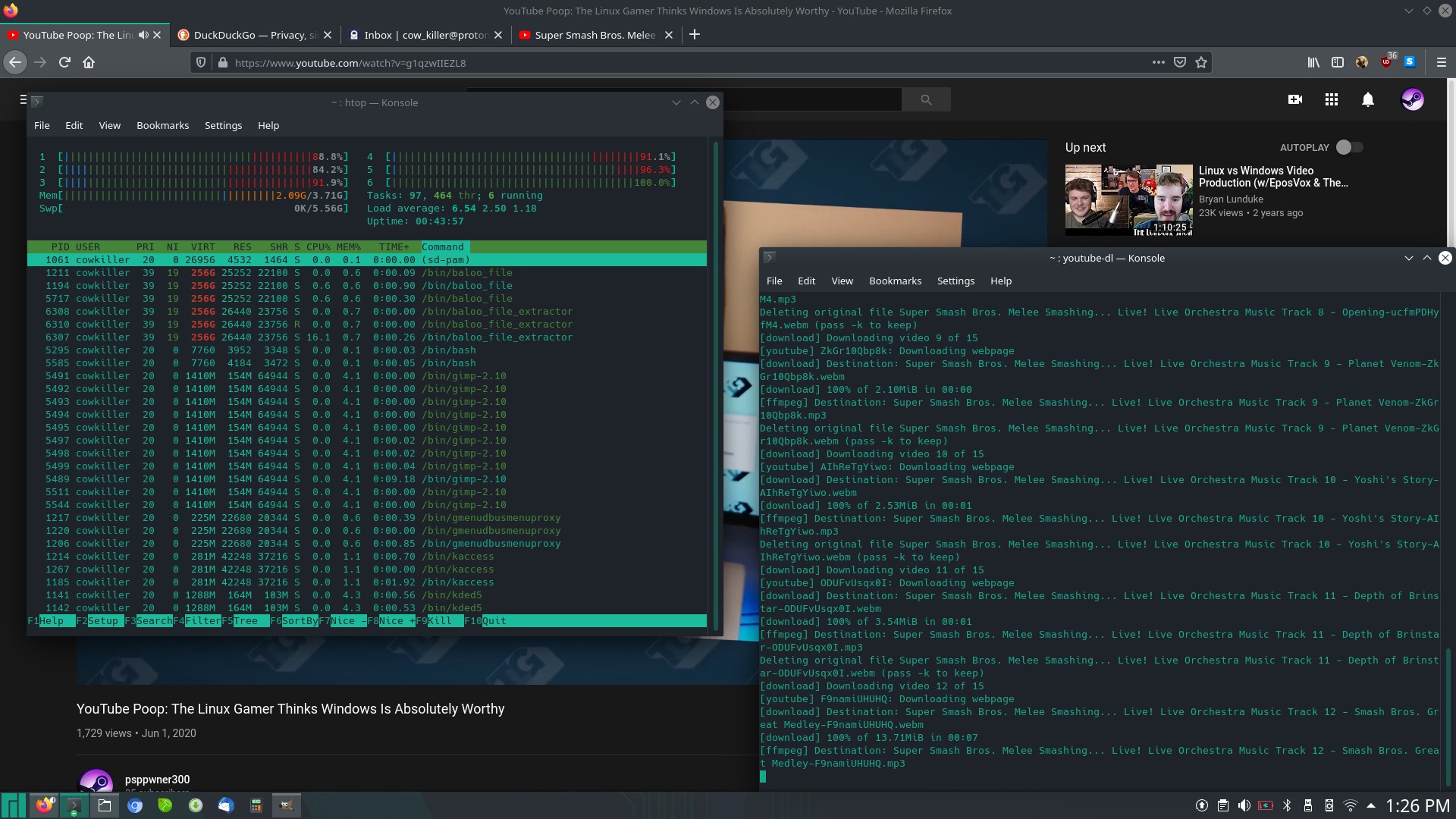
And even during this time the only place where I could feel a bit of heat from the unit was the bottom towards the left side where the PBP gets charged. I was charging the device at the time too, so I’d imagine there would be no heat at all during productivity!
I can’t believe how quiet this thing is. You can’t tell whether the device is on if you were blindfolded, even if you put your ear next to it. The only time I’ve heard a bit of noise was charging the unit.
Battery Life
As far as battery life is concerned, that I currently can’t report because, as I’ll describe later on in the Issues section of this review, there will be occasions where the battery icon won’t show up on the KDE panel, so I won’t have any idea how much battery life is left.
Edit: TLP is installed by default with the PBP, and you can use said program to show battery level:

Battery is 100% as expected, as I had just charged the unit.
Gaming
Naturally, seeing as this is a gaming-oriented site, you’re probably wondering how the PBP fares when it comes to gaming. Well, I can already tell you that trying to flash Recalbox from mrfixit2001’s repository (images specifically made for Rockchip boards) onto a MicroSD card and booting from it resulted in this:
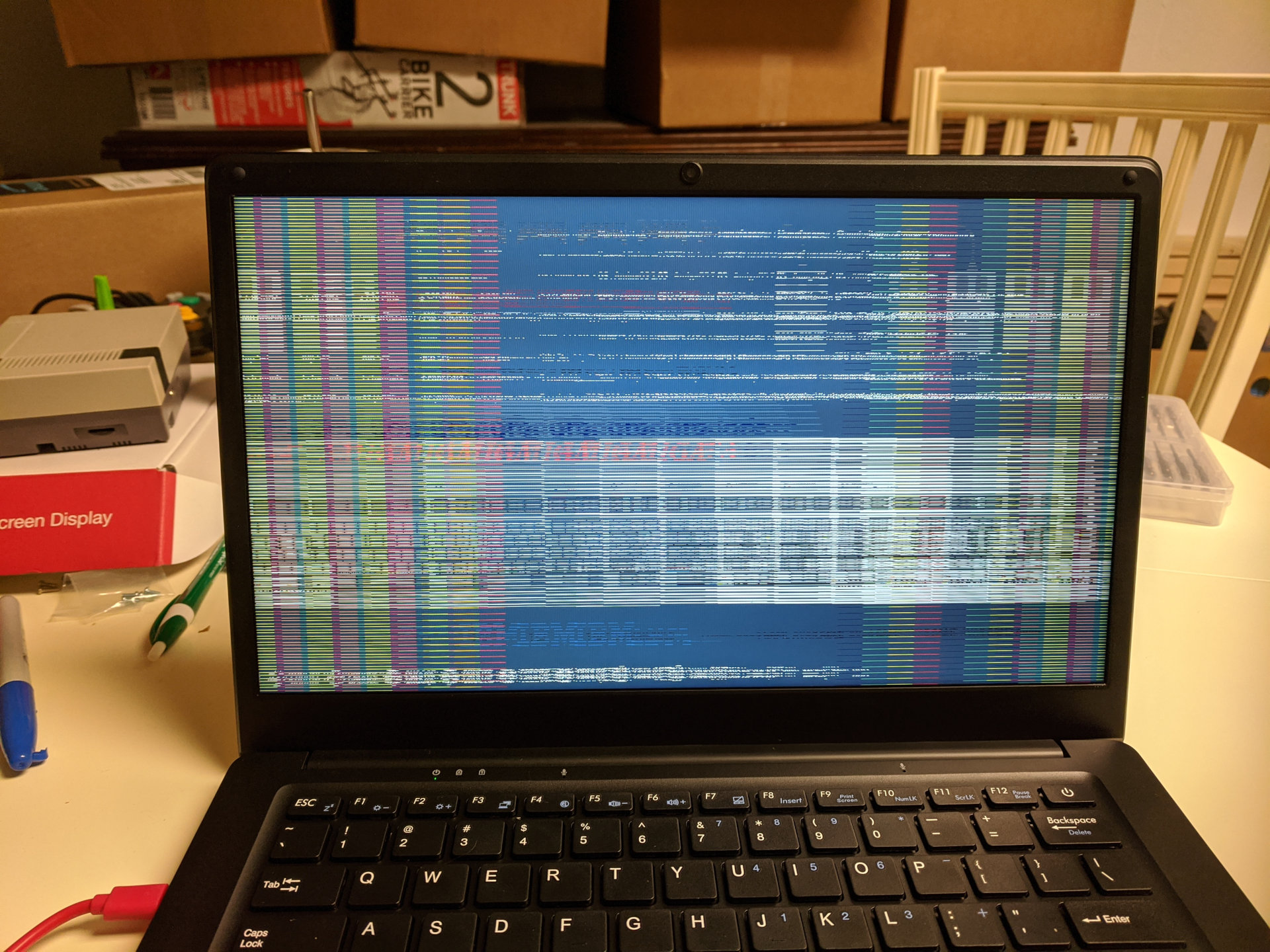
So, I’m left to using Manjaro itself for emulation. I was able to install RetroArch and the appropriate cores. Playing Tony Hawk’s Pro Skater for the original PlayStation resulted in no hiccups. I’d really be interested in seeing how it can fare with GameCube titles, but since Dolphin only works with only a few ARM devices, it’s something we can’t really test for the time being.
YouTube Playback
Testing both Firefox and Chromium, the best video output the PBP can play comfortably on YouTube is 1080p at 30 frames-per-second. 60 FPS played a bit smoother on Firefox than on Chromium, but in both cases the playback was not super-smooth. On Firefox, the CPU cores were being used to the max (so the GPU isn’t doing any of the decoding), whereas with Chromium, the cores hovered around 70%. And forget about 4K; that would produce slideshow quality.
I downloaded a video of earth from space to my PBP. The playback via the mpv player produced no stuttering, but as I compared playback to my desktop, it appeared the playback on the PBP was capped to 30 FPS, all CPU cores being loaded almost to the brim even though mpv supposedly uses GPU decoding. So, the lack of 1080p 60 FPS playback may be a big turndown for some.
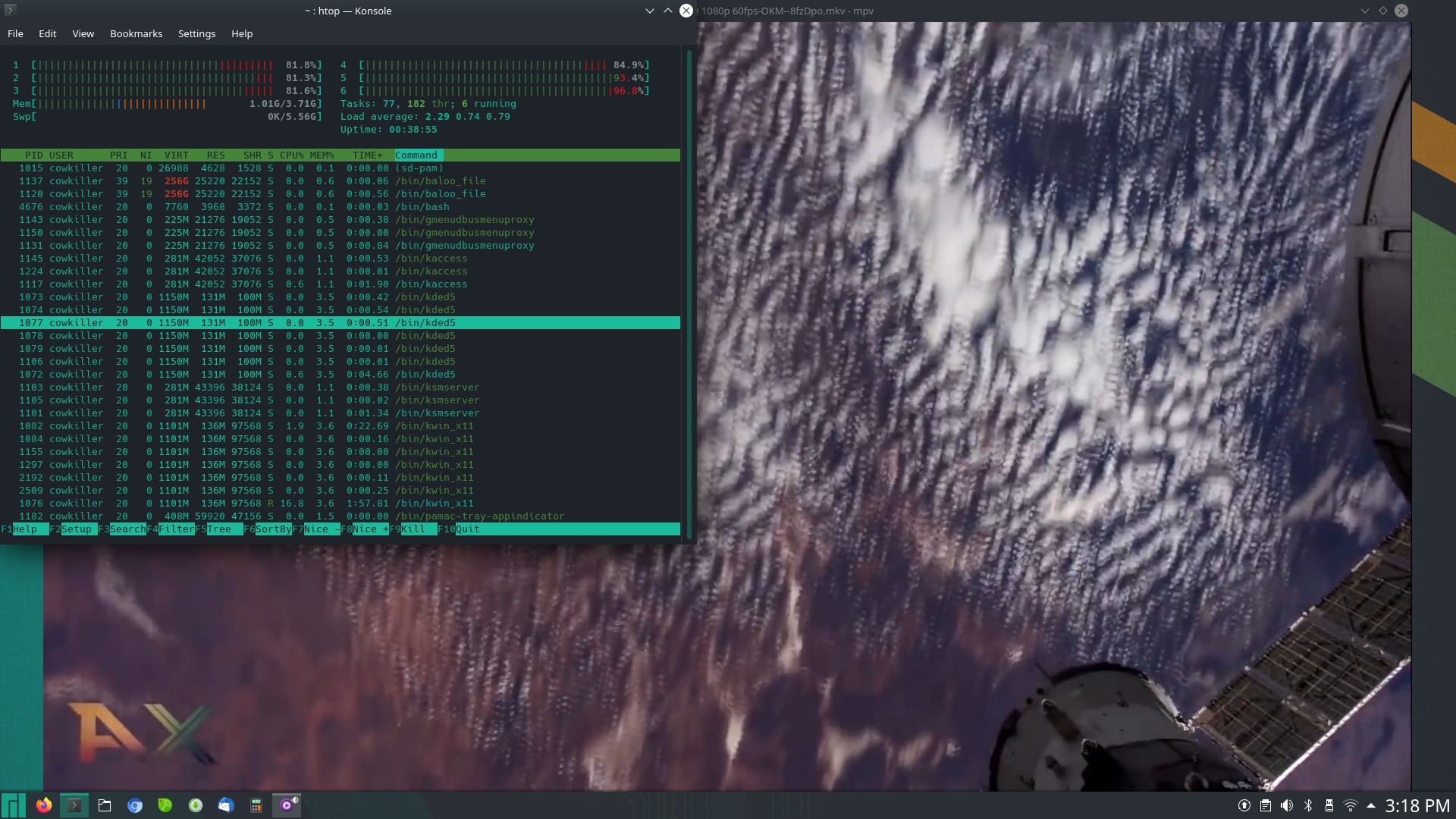
Issues
The first thing I did after powering the unit and setting up my login credentials, was connect to the Internet and check for updates. There were over 500 packages ready to upgrade. One massive download later, I rebooted. Then I discovered I can no longer connect to the 5 GHz band on my local network. Tried everything I could to reconnect, but it refused to show up in my network list. A bit of a head-scratcher there.
As I’m writing this very review on my PBP with Firefox, I’m noticing some lag as I type. After installing and running htop, the system is using less than 2 GB of RAM and barely going above 10% on the CPU cores, yet the lag is very noticeable. Not sure what is causing this.
I’ve run into a few issues with the trackpad. It behaves oddly: after not using it for a second or two, putting my finger back on the trackpad and scrolling causes the mouse cursor to move abruptly, teleporting to the opposite end of the screen. It has caused some frustrating moments while I’m trying to do my day-to-day tasks. No idea what’s causing this either. It may be because I have some gestures enabled that I don’t want. Trying to add a few tweaks didn’t do much. The problem was easily remedied by connecting a mouse.
Sometimes the icon for the battery won’t show up in the taskbar in KDE. Even after manually adding it, it’ll say there’s no battery connected. How am I supposed to know when my laptop suddenly shuts off due to low battery, or know when it’s fully charged so I can test how long it lasts?
There’s also an odd gimmick with adding applications to the taskbar. If I search for an application, right-click it and select “Pin to taskbar”, it does nothing. I found that I have to right-click it, add it to my favorites, right-click the favorite, then pin from there.
The particular version of Firefox shipped with Manjaro ARM has uBlock installed by default. And there’s no way to get rid of it:

It’s a nice add-on, but it’s also a little strange that we cannot easily remove it.
Is It Worth Your Time?
Kind of similar to my review of the PinePhone back when it was in it’s early stages, the PBP has got the hardware right, but the software remains a bit buggy. I’m sure a lot of the issues I’ve described here could easily be fixed with a few additional tweaks, or by just using another OS. Or maybe Manjaro is already aware of these and are working on the solution. For day-to-day use currently? I’m frankly not sure with all the problems I’ve encountered so far. You could probably do it if you can get through the headaches, including the inability to watch 1080p 60 FPS videos, ignoring the trackpad issues by using a mouse, strange Wi-Fi issues and USB-C video output, and poor GPU utilization.
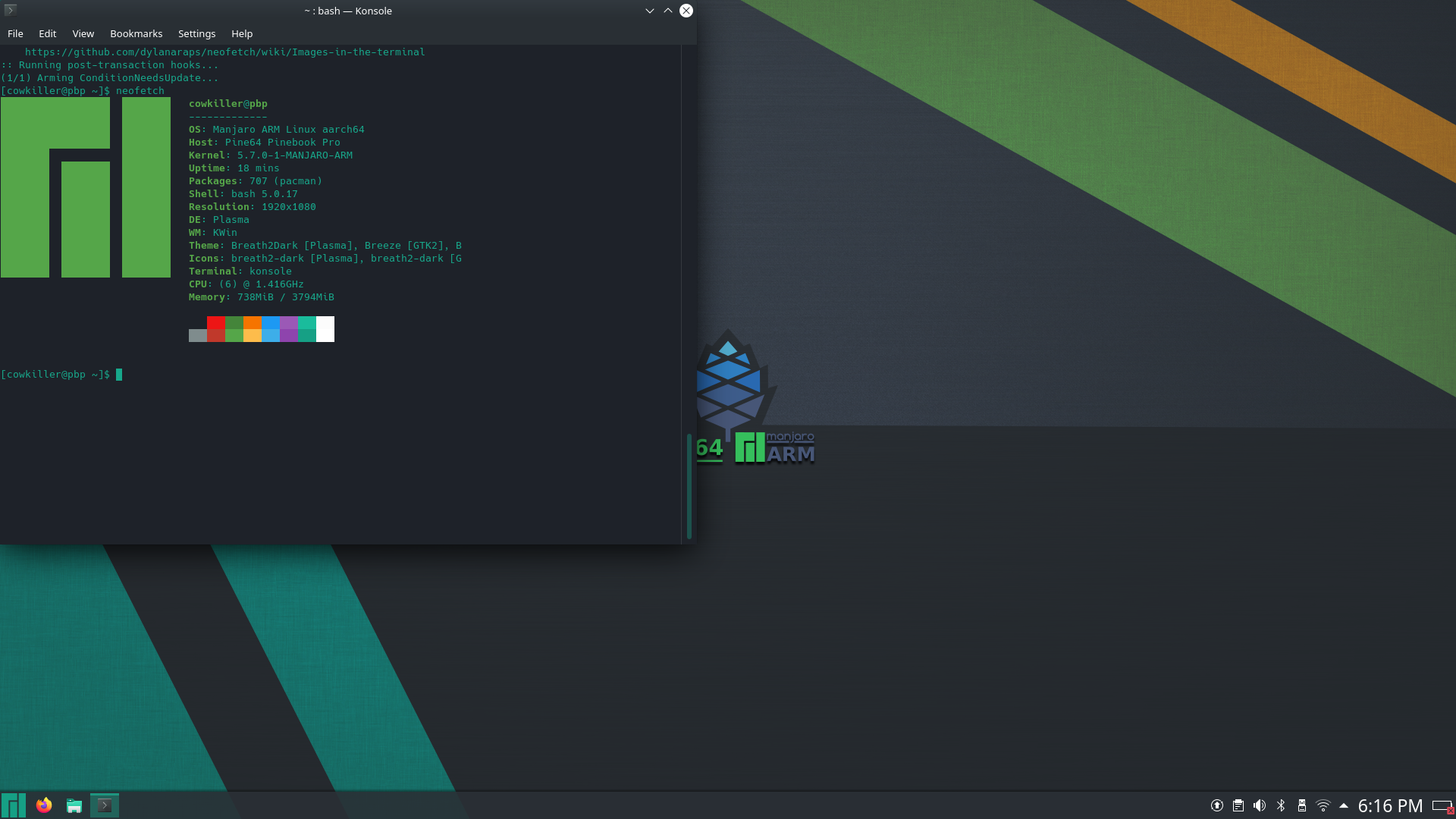
For a $200 laptop though, I can’t really complain. The materials that compose this product are of durable quality, the components that make the device work are pretty beefy for the price tag, the keyboard is decent, and you can still do most of the things that you’re used to doing on a desktop. I can see the PBP or even the original Pinebook as a valuable resource for those that need computers in third-world countries. You may want to consider getting the PBP if you’re in need of a laptop.
